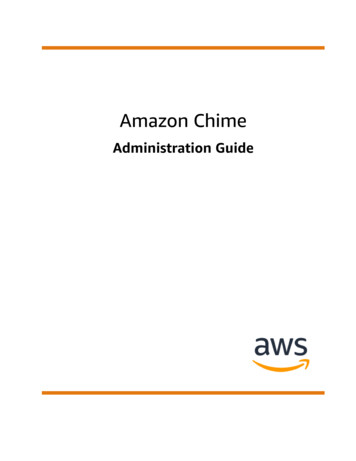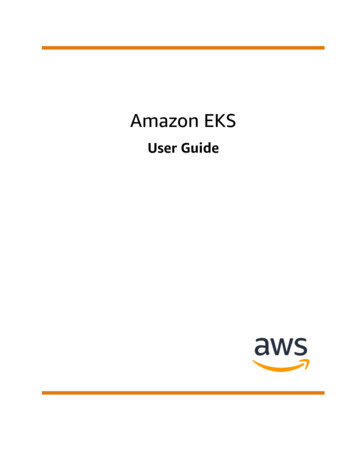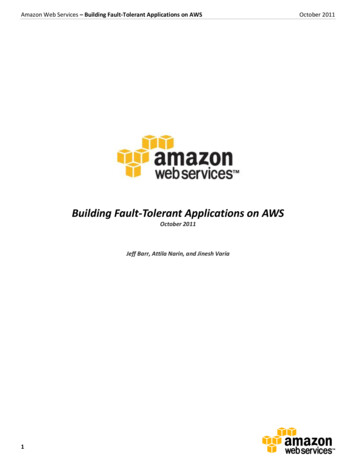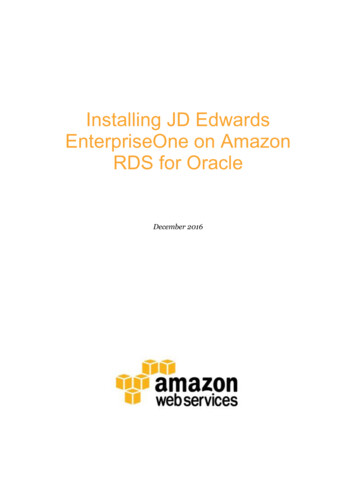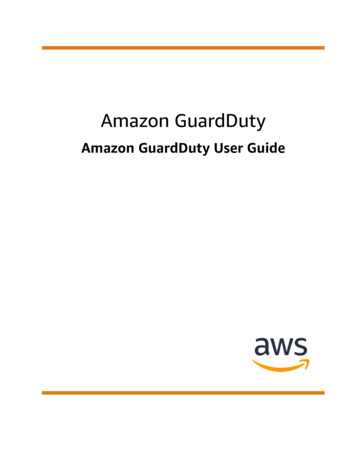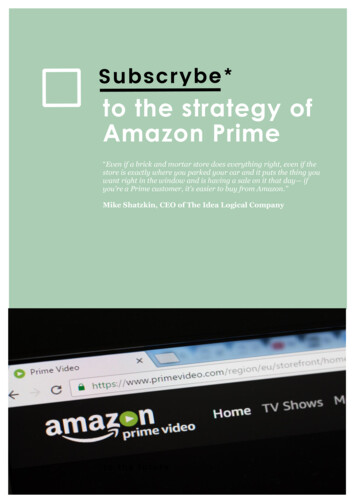
Transcription
to the strategy ofAmazon Prime“Even if a brick and mortar store does everything right, even if thestore is exactly where you parked your car and it puts the thing youwant right in the window and is having a sale on it that day— ifyou’re a Prime customer, it’s easier to buy from Amazon.”Mike Shatzkin, CEO of The Idea Logical Company
Side 2 af 2Overview: Main points and conclusions Amazon is the world’s leading ecommerce business with an annualturnover of more than 100 billionUSD and its growth is still exponential. At the same time, Amazonis one of the world’s leading subscription businesses with AmazonPrime. The service is believed tohave above 80 million membersworldwide. Amazon prime is considered a significant part of Amazon’s greatsuccess. Amazon Prime memberspay an annual sum of 99 USD or amonthly sum of 10.99 USD and getfree two-day delivery on more than15 million different items. Furthermore, Amazon provides its Primemembers with different content including data storage, movies andmusic. The primary purpose for AmazonPrime is to create loyalty betweenAmazon and its customers. Whenthe customer has paid 99 or 10.99USD for free delivery he or she willautomatically wish to get most outof the already paid subscriptionfee. In other words, Prime members get on what we within thesubscription industry call the‘golden handcuffs’; benefits forsubscribers. As a result, Primemembers end up spending threetimes more money as non-members on Amazon.com in addition tothe subscription fee.third of Amazon’s turnover in theUS derives from Prime memberships. Prime is also an importantpart of Amazon’s strategy for thefuture that revolves around a complete disruption of the interplaybetween e-commerce and retailand a domination of the same-daydelivery market. To win the position as the sameday delivery dominator in the market, Amazon has entered the market for groceries in the US. AmazonFresh delivers groceries andother goods directly to the customer’s doorstep on the same dayas the goods are ordered. Primeplays an important role here, too.A PrimeFresh subscription, at anannual sum of 299 USD, gives thecustomers free delivery of groceries as frequent as they like. Other retail- and grocery businesses have much to learn fromAmazon’s subscription success.Businesses have the opportunity totie customers closer to the businessthrough a subscription that createsloyalty and makes the customerspend more on your business andless with the competitors. There is a great chance that we willsee a substantial usage of the subscription model within both the retail market and the grocery market– just as we have seen it in otherindustries the last couple of years. Prime is not just important to Amazon’s current business, whereof aW: subscrybe.dkE: mail@subscrybe.dkP: ( 45) 40 29 45 34Copenhagen office:Store Kongensgade 59A, 4.DK-1264 København KAarhus office:Balticagade 7DK-8000 Aarhus C
Side 2 af 16Introduction: Amazon Prime – the world’s most successful subscription business?Amazon is one of the world’s biggest and also, without any doubt, one of the world’s leading retailers. Also, Amazon remains ahead in the e-commerce market in the U.S. and inthe rest of the world. In 2016, Amazon’s turnover reached a total of 136 billion USD, andAmazon now has a current value of 470 billion USD. Furthermore, the growth rate is notlooking like it is about to stop.Amazon.com aired in the summer of 1995 and since then, Amazon has managed to turnits business from being a digital bookstore into being an Internet-based product giant.Today, it is almost impossible to find any items that Amazon does not sell. This and morehas brought an extraordinary growth and in March 2017 Amazon has a value of 458 almost twice as much as Walmart, which is still the largest retail chain in the U.S. interms of sales.Figure 1. Market cap of Amazon in 2016 compared with selected U.S. retailers(Source: Statista.com)The reason why Amazon isgrowing so rapidly has been discussed quite extensively. Two of the most important reasons are certainly Amazon’s ability to think out of the box in relation to customers andindustries and to reinvest its money. Moreover, the company’s ability to think strategically, innovatively and farsighted at the same time holds importance. These abilities areall rooted in CEO and founder of Amazon, Jeff Bezos’ way of thinking, but also shared bymany of Amazon’s current employees.Amazon Prime is one of these innovative and visionary thoughts that became action.Launched as a loyalty program in 2005, Amazon Prime has made it both easier andcheaper to be a customer at Amazon. In a relatively short time, Amazon Prime changedAmazon from being a traditional transaction-based e-commerce business to a unique andsuccessful subscription business.Along with exponential growth comes expansion of the range of competitors, which wasalso observed by Business Insider in 2014:W: subscrybe.dkE: mail@subscrybe.dkP: ( 45) 40 29 45 34Copenhagen office:Store Kongensgade 59A, 4.DK-1264 København KAarhus office:Balticagade 7DK-8000 Aarhus C
Side 3 af 16“As Amazon expands into more verticals, its sheer number of competitors has exploded,and they're attacking Amazon in ways that are both big and small. Amazon remains astrong company, but it suddenly seems at risk of stretching itself too thin, exposing itself to too many competitors”.Even though this is a two-year-old observation, it is still valid. In 2016, Amazon is still indirect competition with those U.S online retailers identified in 2013. Adding to competitors are video-streaming services such as HBO and Hulu, and “cloud storage” servicessuch as Dropbox. Further, due to its entry into different markets, Amazon has becomeslightly vulnerable to competitors such as app-based e-commerce start-ups and challengers such as Google and Uber. Nonetheless, Amazon currently maintains a leading position.When Amazon Prime launched in 2005, it was introduced as an annual membershipproviding members paying 79 USD a year, free two-day delivery on more than 1 millionof Amazon’s different products. Now, 11 years later, a Prime membership costs 99 USDyearly or 10.99 USD monthly, but in return, the selection of products – still deliveredwith no cost – is now more than 15 million. In accordance, the Prime that we experiencetoday contains far more benefits for customers than it did 11 years ago.Amazon has never released the actual number of Prime members, which has ignitedmany speculations. At the end of 2013, Amazon hinted that the number was more than20 million. Now, three years later Consumer Intelligence Research Partners has estimated the number of Prime members to be around 80 million.There is no doubt that the numbers of members will continue to grow. The last couple ofyears, Amazon has really focused on Prime and the evolution of Prime. Amazon hasadded more elements to Prime and has realised that the concept is not just a convenientservice for its customers. Prime has become a key element in Amazon’s strategy of changing the retail and groceries industry completely.At the same time, customers love Prime to such an extent that Amazon Prime – andhereby Amazon – is becoming the most successful subscription business in the world.This report is looking closer into facts, strategy and perspectives behind Amazon Prime.The report also takes a look at what other companies might learn from the success of Amazon.W: subscrybe.dkE: mail@subscrybe.dkP: ( 45) 40 29 45 34Copenhagen office:Store Kongensgade 59A, 4.DK-1264 København KAarhus office:Balticagade 7DK-8000 Aarhus C
Side 4 af 16Behind Prime11 years ago, in February 2005, the charismatic CEO, Jeff Bezos, announced that Amazonwould release a new and revolutionary concept. The concept was Amazon Prime, a yearbased membership that would give subscribers - regular Amazon users - free two-day delivery in exchange for an annual payment. Prior to this announcement, a hectic development process took place, which was driven by Jeff Bezos himself, who understood theenormous value that could lie in lowering the purchase barrier for loyal customers, andthus making them more loyal.However, Jeff Bezos’ project did not gain much internal acceptance in the beginning.On the face of it, it seemed like an unprofitable undertaking. If new Prime members didnot purchase from Amazon more than 10 times a year, Amazon would lose money on itscustomers. Many within the company, therefore, feared that Prime would turn into a bigmoney monster and become a millstone around the neck of the business. Nonetheless,Jeff Bezos stood his ground and the concerns proved unfounded.During the next six years, Amazon Prime remained faithful to the original concept, whichwas to be a simple delivery system for loyal customers. But then Prime developed in newdirections. In 2011, Prime expanded with a movie service. Furthermore, Amazon Primecontinued its development to be the service that we know today, also containing a musicservice, e-books, a photo storage service, a specialised service for families and muchmore. In 2016, Prime costs 99 USD a year or 10.99 a month and is available in the following countries besides the US: Germany, Japan, England, France, Italy, Spain, Austria andCanada.As mentioned in the introduction, the number of Prime members is unknown and eventhough Amazon has been intensely secretive about this, it seems as if speculations willnever end. In 2015 the estimation was that Amazon Prime had 60 million subscribers,such as assessed by the Business Insider, which is very close to Consumer IntelligenceResearch Partners’ estimation of 80 million Prime members in May 2017.Figure 2. The number of AmazonPrime members estimated byStatista and Business Insider(Source: Statista and BusinessInsider)W: subscrybe.dkE: mail@subscrybe.dkP: ( 45) 40 29 45 34Copenhagen office:Store Kongensgade 59A, 4.DK-1264 København KAarhus office:Balticagade 7DK-8000 Aarhus C
Side 5 af 16The evaluation of future developments of Prime states that Prime, this year, will reach astaggering 85 million users worldwide. But what is it that makes Amazon Prime such agood business idea? How can something that, in principle, save customers money turnout to be a huge success and a vast source of revenue for Amazon?Behind the success is the ‘golden handcuffs’; benefits for subscribersThe fundamental element behind Amazon Prime's success is that users of Prime simplyspend more money once they have become members of Prime. Analysts have calculatedthat Prime subscribers spend up to three times more money at Amazon compared to regular customers. So far, it has seemed as if the increase in turnover quickly equalises Amazon's extra costs on delivery and additional services. Once the Prime subscriber has experienced the benefits of free delivery - and is already in the process of purchasing fromAmazon - the temptation to shop elsewhere is suddenly diminished. Furthermore, thesubscriber can be tempted to buy even more products, as most will have a need to recoupthe yearly lump sum.That is actually no surprise to the people at Amazon. Already at the launch of Prime, JeffBezos had a clear feeling that Prime could help change the behaviour of customers andmake them more loyal. With one-click orders, Amazon had already shown that you couldremove a source of irritation when buying online, and make it easier and simpler to shop.This increases customers’ motivation to buy and the likelihood for them to return moreoften. Jeff Bezos predicted, that the same thing would happen with Prime when they removed another source of irritation; the payment for delivery.Robbie Schwietzer, head of Amazon Prime, has in fact said it even more to the point.Even though this quote is from the days where Prime was 20 USD cheaper than today,the same mechanisms are in play:“Once you become a Prime member, your human nature takes over. You want to leverage your 79 as much as possible. Not only do you buy more, but you buy in a broaderset of categories. You discover all the selections we have, that you otherwise wouldn’thave thought to look to Amazon for.”- Robbie Schwietzer, VP Amazon PrimeIn other words, Prime members get on what might be called the ‘golden handcuffs’; benefits for subscribers, a phenomenon that is also known from other subscription businesses. The customer is more loyal to the company, where the subscription is purchased,because he or she feels that once the subscription is paid for, it is all about getting asmuch as possible from the already paid subscription. This causes the subscriber to turneven more to the company and familiarise him- or herself less with competitors.W: subscrybe.dkE: mail@subscrybe.dkP: ( 45) 40 29 45 34Copenhagen office:Store Kongensgade 59A, 4.DK-1264 København KAarhus office:Balticagade 7DK-8000 Aarhus C
Side 6 af 16Thus, Prime has proved to be a powerful tool in building a strong relationship betweenAmazon and its customers. A relationship that has resulted in increased loyalty, morepurchases and higher revenue per customer. But Prime is not only a means to lift the current business. Prime is also a very important component in Amazon's future strategyconcerning changing the retail and grocery market in the world. We will get back to thatlater in this report.Prime in numbersA customer, who is a member of Prime, spends, as mentioned earlier, three times moremoney with Amazon than a regular Amazon customer. More precisely, market researchshows, based on US data, that a Prime member spends about 1,500 USD yearly from Amazon compared with 625 USD used by customers that are not Prime members.Also, the number of Prime memberships rose by 53 per cent in 2014, despite the changein the yearly subscription price from 79 USD to 99 USD.Nevertheless, the recent initiative to make it possible for Prime members to pay amonthly subscription fee of 10.99 USD and to make Amazon Prime video streamingavailable to all Amazon users for 8.99 USD a month has generated some speculations onwhether the annual subscription fee will increase. These speculations arise from breakingdown the new monthly subscription fees over the course of a year. If you add them up toa 12-month subscription payment they reach a full year payment of 131.88 USD for thePrime membership and 107.88 USD for the Prime video membership. Only time will tellif Amazon has any intensions to raise prices, however, to exceed the psychological 100USD barrier would seem as a big step to take.One of the essential objectives of Prime is obviously to create value for Amazon, but it isunquestionably not difficult to understand that the service is also quite valuable for theconsumer. Looking at the competition, you can easily pay 99 USD for just one of the alternatives that Amazon offers. With Prime you get all together in one package, whichamong other products and services includes Prime Music, Amazon's music streamingservice, Prime Instant video, a video streaming service, and Amazon Cloud Drive, Amazon's "cloud storage". For example, Netflix costs 96 USD per year, Spotify Premium costs120 USD per year, and Dropbox, with associated 1 terabyte data also costs 120 USD peryear.Yet, it is not even in the bundling aspect that the consumer saves the most money. If youanalyse it, consumers can save most money on the delivery. A standard delivery with UPS(United Postal Service) costs between 10 and 15 USD for a normal package. One does nothave to order more than ten packages a year before it becomes a good business, and thereare many examples of users that have ordered even more packages than that. New YorkTimes has written about a user with 90 orders at Amazon over the past year - thatamount would approximately round up to a total of 1,000 USD just for delivery.You can clearly see a consumer pattern; Prime is worth the money for the subscriber.W: subscrybe.dkE: mail@subscrybe.dkP: ( 45) 40 29 45 34Copenhagen office:Store Kongensgade 59A, 4.DK-1264 København KAarhus office:Balticagade 7DK-8000 Aarhus C
Side 7 af 16But as mentioned earlier, it has to be profitable for both parties before it turns into agood business. There is no doubt that the actual delivery cost is not profitable for Amazon, but that does not seem to be important, if you get the customer to spend moremoney when the customer is at your site. Besides, Amazon obviously earn money on theactual subscription fees: If Amazon Prime has 50 million users - and we assume thatabout 10 million of those are on a trial basis or other special basis - Amazon roughlyearns 4 billion USD just on the subscription payment. According to analysts, around onethird of Amazon's US turnover today is from Prime in the form of subscription revenueand in terms of the products Prime members buy.The development of PrimeAmazon Prime began as a service that offered its customers free two-day delivery. Sincethen, Prime has been continuously developed and expanded, and today the service ismuch more than just free delivery. Here is a review of the developments of Prime and theservices that are available today:Free two-day deliveryThis was where it all started. For six years, Prime was solely a free two-day delivery service and it was, for the subscribers, a genuine success. It was possible to get free deliverywith your purchase, if you ordered for more than 25 USD and was not a Prime subscriber- but as a Prime subscriber you could order anything you wanted without paying for thetransportation. Of course, you indirectly paid for the load - in the form of the yearly payment - but at the end most customers saved more on the free transport than he or shepaid in the subscription sum.Actually, it was rather clear that Amazon was losing money in the beginning. From thebeginning, it was far from being a money machine. It was more important for Jeff Bezosto build customer loyalty. Bezos and his team knew from past experience, that such aninitiative would change how customers behaved and motivate them to yield even largerorders. Prime customers were, as Jeff Bezos predicted, loving the free delivery serviceand therefore ordered indiscriminately; more, bigger and different goods than previouslypredicted. The foundations for Prime was born and today, the free two-day delivery service has extended to more than 15 million items. The free delivery service remains a cornerstone of Prime for most members.Amazon also participates in the collaborative consumption wave. As a customer, it is possible to share your membership. Prime subscribers can share their free two-day deliveryservice with up to four members of the family or with their workplace. However, it is onlythe delivery that can be shared - not music, movies or other Prime goods.If Amazon misses the scheduled delivery date for Prime subscribers, the subscriber can,as compensation, look forward to a one-month free extension of their Prime subscription.W: subscrybe.dkE: mail@subscrybe.dkP: ( 45) 40 29 45 34Copenhagen office:Store Kongensgade 59A, 4.DK-1264 København KAarhus office:Balticagade 7DK-8000 Aarhus C
Side 8 af 16Prime Instant VideoThe video service competes with some relatively big players including Netflix, Hulu andHBO. Nonetheless, there are many indications towards that Prime Instant Video is ahuge success, especially with reference to getting users to subscribe to Prime or gettingusers to continue to stay with Prime.The video service is quite simple containing a large selection of available movies and series, familiar to Netflix. Amazon has even added self-produced TV-series, like Bosch, toits assortment, and it does not seem as if the development and the competition with thebig players is over – Amazon has only just begun to challenge this segment.As for the video service's importance in relation to the rest of the service, some studiesshow that members, who watch videos on the streaming service, renew their membershipfar more often than those, who do not use the video service, and that those who use thestreaming service during their 30-day trial period are more likely to convert to the fullversion of Prime.Recently, Amazon Prime Video has become available to all Amazon users, as astandalone option for 8.99 USD a month after a 30-day free trial. In this way, Amazondirectly challenges competitors like Netflix, who offers its standard service for 9.99 USDa month.Amazon StudiosAmazon Studios is an additional step in Amazon's long-term plan to reach as many usersas possible. Amazon Studios is Amazon's own film production service and intends to produce both TV series and movies. Currently, it has only produced television series, but upto several films have been announced and scheduled. Amazon is trying to involve its users in Studios by giving them the opportunity to come up with the next House of Cards orGame of Thrones. At Studios, it is possible to submit one’s project or idea and at best toget it produced. Here we are of course talking about extreme cases, as the service is notan amateur service. But the concept itself and that the opportunity is there, make theuser know, that Amazon finds it important to involve its users in its operations.As a Prime-subscriber there are of course some advantages, besides having access to thestreaming service. Early access to specific television series (and probably movies, whenthey come) is available to the subscriber, as well as ideas, tests, and other things in connection to the film will also be available for the subscriber to a certain extent.W: subscrybe.dkE: mail@subscrybe.dkP: ( 45) 40 29 45 34Copenhagen office:Store Kongensgade 59A, 4.DK-1264 København KAarhus office:Balticagade 7DK-8000 Aarhus C
Side 9 af 16Prime MusicPrime Music is Amazon's music streaming service. Here users get access to over a millionsongs that can be freely downloaded to a "Prime-Library". Prime users also have the opportunity to buy a CD at a lower price than usual, even if these purchases are rare inthese times.Compared with Spotify and other music services, Prime Music’s selection is not ostentatious, as the competitors have over 20 million songs available, but simply that the selection exists is incredibly important and gives the loyal customers good value for theirmoney. The service is a strong sign from Amazon to its customers about constantly wanting to be where the consumers are, and that it strives to make Prime more than just"worth the money".Due to the recent initiative of making Prime Video a separate service, it now seems morelikely that Prime Music, in the future, could bring new competition to Spotify and AppleMusic.Amazon Cloud DriveAmazon Cloud Drive is Amazon's "cloud storage"; Amazon's response to Dropbox.Here, users can store files from their computers, so that it has a backup and so that thecomputer memory does not get filled up.In addition, as a Prime user one gets just that extra thing - you get an unlimited photostorage with Amazon Prime Photos. This photo storage service was added to Prime in2014 and the service gives Prime users a direct backup of their images on their phones,which is also unlimited, and which reportedly receives the vast majority of image files.The photo storage gives all users of Amazon Prime a sensible reason not to use Dropbox,and in this way, increases its own lever on the different customer segments.Amazon MomAmazon Mom is a further membership in Prime. As a Prime subscriber, it is possible tosubscribe as either a parent or a family member, and in this way, save 15-20 per cent ondiapers and similar products. However, the name has been in a bit of a limelight and hastherefore been changed to the more appropriate "Amazon Family".W: subscrybe.dkE: mail@subscrybe.dkP: ( 45) 40 29 45 34Copenhagen office:Store Kongensgade 59A, 4.DK-1264 København KAarhus office:Balticagade 7DK-8000 Aarhus C
Side 10 af 16Six months of free membership for studentsMany of tomorrow's customers are currently students. They come into the market withknowledge of digital services, they are known as very convenience-seeking, and they havea relatively great willingness to buy. But most importantly, an early influence on thesepeople can create long relationships with a solid amount of trust and consequently a hugepotential customer segment.Prime Student is an offer to all students in higher education in either the UK or the US,which includes a six-month free Prime membership. This means that young people havethe opportunity to enjoy the service of free delivery for half a year. As one can shop bothbooks and clothes at the same place, there is no doubt that the convenience of Prime isvery attractive to young buyers.Kindle and Prime Library39 per cent of Amazon's consumers in the US allegedly own a Kindle reader.Kindle users, who are not necessarily Prime subscribers, are often mentioned as just asgood customers as Prime subscribers, because they tend to purchase more than the"standard" customer.Kindle is the name of Amazon's e-book reader, which gives users the possibility to purchase, download and read e-books on their tablet anytime. The Kindle also works in conjunction with Prime Library, which gives Prime subscribers the possibility to borrow ebooks for free from the website or the app.Prime NowPrime Now is a relatively new concept from Amazon that comes from the idea of fast delivery – Prime Now just has to be even faster. In 2014 the idea of delivery within an hourin the Manhattan area of New York was launched. The goal was, that the concept shouldbe implemented in several cities during 2015. It is now available in cities such as Atlanta,Chicago, Dallas, Las Vegas, Miami, Orlando, Phoenix, Portland, Sacramento, San Francisco Bay Area, Virginia Beach and more. The concept is very simple: For 7.99 USD,Prime subscribers can receive supplies of certain goods on the doorstep within one hour.If it takes two hours, the delivery is free. This gives Amazon a brand-new opportunity tochallenge the traditional shopping patterns, as it is usually the time used to go to the supermarket and back again – now most Prime members can save that time for somethingdifferent. This gives the subscriber an excess of time and more freedom.W: subscrybe.dkE: mail@subscrybe.dkP: ( 45) 40 29 45 34Copenhagen office:Store Kongensgade 59A, 4.DK-1264 København KAarhus office:Balticagade 7DK-8000 Aarhus C
Side 11 af 16Prime FREE- Same-Day DeliveryAccording to a report from Business Insider, it has been expected that the market forsame-day delivery in the US would explode in the coming years. Unsurprisingly, Amazonhas beaten this speculation to the punch by already implementing a free same-day delivery for Prime members in eligible zip codes in the US.The "Holy Grail" in e-commerce is same-day delivery - that is, when the goods are delivered to the consumer the same day that he or she ordered them, and often within a fewhours after ordering. Therefore, the biggest change in the relationship between e-commerce and physical stores has been expected to happen, when the time that passes fromthe customer orders a product until it is delivered is so short that it is not worthwhile forthe consumer to pick up the product himself or herself. Amazon is currently contributingto this change.Amazon Prime AirAmazon Prime Air is not a finished concept . yet! It's all about air delivery via drones,and it is something that Amazon and Jeff Bezos have looked forward to in a while now.The project seems viable, since 86 per cent of Amazon’s parcels actually weigh less than adrone can carry. For Amazon, it would provide an opportunity to economise the persondelivering the packages. For the subscriber, it would not just be a great experience tohave your package delivered through the air, but in the long run it would probably also bethe fastest delivery.Prime DayLast year Amazon Prime launched a rival to Black Friday – its one-day sale event, PrimeDay, which is meant to reward Prime subscribers with exclusive deals ranging from dealson electronics, such as tablets, TV and laptops to clothing, shoes, jewellery, kitchenwareand so on. Amazon Prime Day 2016 was supposedly the ‘biggest day in the history of Amazon’. According to Techradar, “Amazon says it shipped 60 per cent more productsworldwide compared to Prime Day 2015, with a 50 per cent boost in its home territory ofthe US.” Obvious to most, Prime Day is yet another success of Amazon.W: subscrybe.dkE: mail@subscrybe.dkP: ( 45) 40 29 45 34Copenhagen office:Store Kongensgade 59A, 4.DK-1264 København KAarhus office:Balticagade 7DK-8000 Aarhus C
Side 12 af 16Amazon Dash ButtonThe Dash Button is one of the most recent initiatives launched by Amazon, which is a WiFi connected button that, when pressed, instantly purchases or reorders a product fromAmazon. The Dash Button is linked to a product of your choice, so that when you are running low on products, such as washing powder for your washing machine, toilet paper,dishwashing tablets, coffee, hand lotion, diapers or the like, you simply press the button.Amazon will, thereafter, deliver the products to your doorstep, just as with any other Amazon Prime delivery. Essentially, this service is exclusively for Prime members, andseems as another attempt for Amazon to handcuff its members into its Prime subscription service.The Dash Button costs 4.99 USD, which is the same price that members will receive ascredit after their first press on the button. Amazon first launched the Dash button in theUS last year in March and has been available in three other countries outside the US:The U.K., Germany, and Austria. This service is about ultimate convenience for consumers, who can choose between more than 40 brands, such as Air Wick, Ariel, Dettol, Vanish, Gillette, and Nescafé. Moreover, the Dash Button is also an opportunity for brands,such as Siemens, Boss and Whirlpool to increase in sales. This is seen as a possibility forthese brands to produce dishwashers and washing machines with an Dash Replenishment Service (DRS) integra
Amazon prime is considered a sig-nificant part of Amazon's great success. Amazon Prime members pay an annual sum of 99 USD or a monthly sum of 10.99 USD and get free two-day delivery on more than 15 million different items. Further-more, Amazon provides its Prime members with different content in-cluding data storage, movies and music.



![Index [beckassets.blob.core.windows ]](/img/66/30639857-1119689333-14.jpg)

